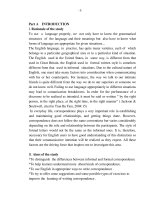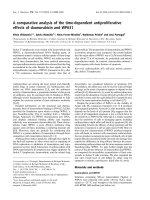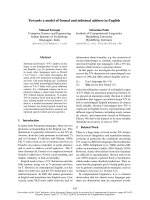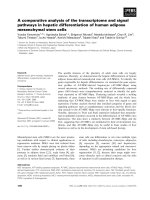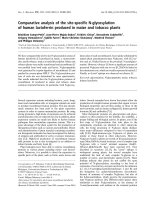Comparative analysis of english formal and informal correspondence
Bạn đang xem bản rút gọn của tài liệu. Xem và tải ngay bản đầy đủ của tài liệu tại đây (192.41 KB, 45 trang )
-1-
Part A Introduction
I. Rationale of the study
To use a language properly, we not only have to know the grammatical
structures of the language and their meanings but also have to know what
forms of language are appropriate for given situations...
The English language, in practice, has quite many varieties, each of which
belongs to a particular geographical area or to a particular kind of situation.
The English used in the United States, in some way, is different from that
used in Great Britain, the English used in formal written style is somehow
different from that used in informal situations. Due to the cultural nature of
English, one must take many factors into consideration when communicating
with his or her counterparts. For instance, the way we talk to our intimate
friends is quite different from the way we do to our superiors or someone we
do not know well. Failing to use language appropriately in different situations
may lead to comunication breakdowns. In order for the performance of a
discourse to be realized as intended, it must be said or written “ by the right
person, in the right place, at the right time, in the right manner” ( Jackson &
Stockwell, cited in Tran Ba Tien, 2004:15)
In everyday life, correspondence plays a very important role in establishing
and maintaining good relationships, and getting things done. However,
correspondence does not follow the same conventions but varies considerably
depending on the role and relationship between the participants. The style of
formal letters would not be the same as the informal ones. It is, therefore,
necessary for English users to have good understanding of this distinction so
that their communicative intention will be realized as they expect. All these
factors are the driving force that inspires me to investigate this area.
II. Aims of the study
*To distinguish the differences between informal and formal correspondence
*To help learners understand more about kinds of correspondence.
*To use English in appropriate ways to write correspondence .
*To try to offer some suggestions and some possible types of exercises to
improve the leaming of writing correspondence .
-2-
III. Methods of the study
* Statistic method.
* Contrastive and comparative method .
* Analysis and systematic method .
Obtaining advice from experts.
IV Scope of the study
Due to the time limitation, we only focus on English formal and
informal correspondence.
V Design of the study
Part A INTRODUCTION
1. Rationale of for choosing the subject
2. Aims of the study
3. Methods of the study
4. Scope of the study
5. Design of the study
Part B DEVELOPMENT
Chapter I: The theoretical background
Chapter II : English correspondence and its properties
Chapter III : Some suggestion for implication
Part C CONCLUSION
References .
-3-
Part B DEVELOPMENT
Chapter I: Theoretical background
1. Discourse
Traditional linguistics have focused on phonological, lexical and syntactical
features which are considered the basis of language knowledge. Meanwhile, the
current view is concerned with understanding of stretches of language which can
only be obtained if they are considered “in their full textual, social and
psychological context” (Cook -1990). Although different theorists have their own
definition of discourse, it is generally refered to as “the language in use for
communication”.
1.1 Discourse and text
A distinction should be made between Discourse and Text. Crystal (1992: 72)
distinguishes that “text” should be reserved only for writing and “discourse” for
speech. According to Cook (1989 : 158), “text” is a stretch of language
interpreted formally without context whereas “discourse” is “stretches of
language peceived to be meaningful, unified and purposive” (ibidi) Halliday and
Hasan (1976 : 1), however, use these two notions interchangeably. They use
“text” to actually refer to “discourse” for they say “a text is unit of language in
use” and “it may be spoken or written, prose or verse, dialogue or monologue”.
Brown and Yule (1983 : 6) point out that texts are the presentation of discourse
and verbal record of a communicative act.
1.2 Spoken and written discourse.
Both spoken and written discourses are different modes of expressing linguistic
meaning. Besides their similarities in some aspects, they still have some
differences.
Spoken discourse is often considered to be less planned or orderly, more open to
intervention by the receiver while written one is well- structured and the
possibilities for subordinate are very limited.
The traditional distinction is based on the difference on production and reception.
We use our mouths and ears for spoken discourse and our hands and eyes for
witten one .
-4Brown and Yule (1983:13 ) point out that spoken and written discourse serve
various functions. The first is used for the establishment and maintenance of
human relationships (interactional use) and the second for the working out of and
transference of information (transactional use ).
To sum up, the main difterence between them is seen from the fact that spoken
discourse is changeable and written is permanent .
1.3 Discourse context
1.3.1 The context of situation
Context of situation or context, in D.A, is an essential factor for interpreting the
discourse. “A context can support a range of meaning” (Hymes, quoted in
Brown and Yule,1983). David Nunan (1983;7) states that “context refers to
situation giving rise to the discourse and within which the discourse is
embedded”. According to him, context should be divided into two types :
linguistic and non- linguistic. The former surrounds on accompanies the piece of
discourse under analysis. The latter includes the type of communicative event,
the topic, the purpose of the event, the setting, the participants and the
relationships, between them and the background knowledge and assumptions
underlying the communicative event.
Following Hymes’ view, Brown and Yule (1983) have also specified the features
on the context similar to Nunans’.
1.3.2 Context versus co- text.
Context is obviously different from co-text. David Nunan points out that co-text
is the linguistic element and the non-linguistic one is the context. According to
Brown and Yule (1983); any sentenece other than the first in a fragment of
discourse will have the whole of its interpration forcibly constrained by the
proceeding text “and” the words occur on discourse are constrained by their cotext. Lets examine the following example :
Australians are proud of their egalitarian society and boast about it They are
right : their society is more egalitarian than any other and this is a trait to be
proud of. But when informality is a cult, you have to learn how to be informal...
(From Longman advanced English (1986-1987: 20 ).
-5The word “informal” indeed posseses some different meanings. Each meaning is
detemined by its context, therefore, it is constrained by co-text .The readers may
find its lexical content in a dictionany and how its interpretation changes when it
is embedded within the co-text. The initial setting of the co-text determines the
extent of the context within which the hearer will understand what is said next.
Co-text, a linguistic element helping to clarify the internal meaning of language,
is the actual text surrounding a particular sentence as stated by Brown and Yule
(1983: 49) “ the more context there is , the more secure the interpretation is”. To
J. R. Firth, a context of situation for linguistic work brings into relation the
following categories:
A-The relevant features of participants : persons, personalities including their
verbal and non -verbal action
B-The relevant objects
C-The effect of the verbal action
They are seen to be external to the text, so considered to be non –linguistic.
However, it is possible to reconstruct at least some part of the physical context
and to arrive at some interpretation of the text. Communications do not merely
depend on the context for their interpretation, they change that context
(Isard,1975)
In summary, context involves non-linguistic elements and co-text the linguistic
ones .
2. Cohesion and coherence .
2.1 Cohesion versus coherence
Viewing from some points, the concept of cohesion is closely connected with
discourse. It is considered as the grammatical and lexical relationships between
the different elements of a text in Richard et al’s view. This relationship may be
between different sentences on between difterent parts of a sentence. For
instance,
Betweeen different sentences:
I saw your ad. in the paper about a good, well-paid job taking foreigners
around Britain, and I am quite interested .I went to the normal sort of schools
and got most of the “o” level I took plus a few CSEs, that was in 1978 or 1979.
Since school, I’ve been around quite a bit. I had about two years in a school
-6near Bristol looking after their social and sports programme and have spent a
few summers showing tourists round England, which I quite liked. I presume that
that experience could be useful in some way in some place... (Longman
Advanced English,1986-1987: 61 )
Between different parts of sentence:
Because my introduction was too short, I had to rewrite it.
(Guido Telemans, 1998-1999)
In this sentence, there is obviously a link between “my introduction” and “it”.It is
used to refer to “my introduction”.
As for Nunan (1993), coherence is “the feeling that sequences of sentences or
uttrances seem to hang together”. The following dialogue may provide an
illustration :
A-Clare loves potatoes
B-She was born in Ireland
(Guido Telemans, 1998-1999)
Although the response seems unrelated to the former sentence, it becomes
coherent if A already knows the sterotype ethnic association between being Irish
and loving potatoes.
Cohesion is only a guide to coherence and coherene is something created by the
readers in the act of reading the text. Those are the essential elements that make
the text or discourse coherent and different from random ones. In summary,
cohesion refers to the grammatical and lexical relationships between the different
elements of a text whereas coherence refers to the relationships linking the
meanings of utterances in a discourse or of the sentences in a text. Coherence is
embodied by a system of cohesive devices and cohesion, is maily used to
embody coherence.
2.2 Cohesive devices
Coherence of discourse is associated with cohesion expressed by cohesive
devices. Halliday and Hasan (1976) provide a comprehensive description and
analysis of these cohesive devices. They stated that there are five different major
types of cohesion, namely reference, substitution, ellipsis, conjunction and
lexical cohesion.
2.2.1 Reference
-7Michael Mc Carthy (1991) points out that reference items in English include
pronouns, demonstratives, the article and items like “such a”. Halliday and
Hasan (1976) identified two kinds of reference : exophora and endophora.
However, we only mention to the one used within a text : endophara. Endophora
can function in two ways : anaphoric and cataphoric. Anaphoric reference can be
confirmed by looking back in the text.
E.g. Doctor Foster went to Gloucester in a shower of rain. He stepped in a
puddle right up to his middle and never went there again
(Halliday and Hasan,1976)
The pronoun “he” refers back to the previously mention name ”Doctor
Forster”.The pronoun “they” refers back to the previously mention name
“Doctor Foster”.
The demonstrative “this”in the following example can replace the whole sentence
“he wins in the election”
A : He wins in the election
B : I can not believe this
Cataphoric reference can be identified by looking forward in the text. It can also
be expressed in three different items : pronouns, demonstratives and comparison
as of anaphonric . Some examples can be effective illustration for this:
They pressed round him in ragged fashion to take their money, Andy, Dave, Phil,
Stephen, Bob.
(Graham Snift, the Sweet shop owner, Penguin Books Limited,1983:13 )
It is clear that “they” refers forward “Andy,Dave,Phil,Stephen, Bob”
Cataphoric demonstrative can be seen in:
This is the most famous singer, Elvis Presley.
2.2.2 Ellipsis
Ellipsis is the omission of elements required by the grammar which the speaker/
writer assumes are obvious from the context and therefore need not be raised.
There are three types of ellipsis: nominal,verbal and clausal.
E.g. * Nominal: Nelly liked the green tiles, myself I preferred the blue (tiles)
*Verbal: Do you usually go out at night? No,I do not (usually go out at
night)
* Clausal: He said he would take early retirement as soon as he could and
he has (taken early retirement)
-82.2.3 Substitution
Substitution is similar to ellipsis, in that, in English, it operates either as nominal,
verbal or clausal level.
*Nominal: She chose the roast duck; I chose the same
*Verbal: Did Mary take that letter? She might have done
*Clausal: Do you need a lift? If so, wait for me;If not, I will see you there
2.2.4 Conjunction
A conjunction does not set off a search backward or forward for its referent, but
it does presuppose a textual sequence, and its signals a relationship between
segments of the discourse. There are four main kinds of conjunctions: additive,
adversative, causal and temporal.
*Additive: signals the presentation of additional information like and, in
addition, similarly...
E.g. She is intelligent.and she is very reliable
*Adversative : but, however, yet...The information in the second sentence of
the text moderates or qualifies the information in the first.
E.g: I have lived here ten years but I have never heard of that pub.
*Causal: because, consequently, hence...The relationship here is one of cause
and consequence
E.g: He was insensitive to the groups’need. Consequently there was a lot of
bad feeling.
*Temporal: the events in the text are relate on terms of timing of their
occurence such as : first, then, next, secondly, finally...
E.g: I got up then made my breakfast.
2.2.5 Lexicalties.
When two words in a text are semantically related in some way, lexical
cohesion occurs. According to Halliday and Hasans’ view, there are two major
categories of lexical ties: reiteration and collocation.
a-Reiteration
Reiteration involves repetition, synonym (and near synonym), super ordinate
and general word.
b-Repetition
-9I would like to commend your organization for the important contribution it
makes to our community, and I wish you and the other board members
contimed success.
c-Synonym
Nike invites people to call in . It has encouraged thousand of potential
consumers to reach for the telephone.
d-Superordinate and hymponym
People can dial up and listen to celebrities talking to each other. Famous
athletes were employed to celebrities to record the messages.
In this example. “people” is superodinate, “athletes” is hympony
3. Politeness
3.1 What is politeness?
Generally speaking, being polite is making people feel good, or in other words,
politeness means showing consideration to others. The concept of politeness
has been overwhelmingly discussed. Lakkoff regards politeness as “ a system
of interpersonal relations designed to facilitate interactionby minimizing the
potential for conflict and confrontation inherent in all human interchange”
( cited in Tran Ba Tien: 27). Yule specifically lists the characteristics of
politeness, including “ being tacful, generous, modest and sympathetic toward
others”( 1997: 60). Brown and Levison (1987) see politeness as a
strategy/stategies used by a speaker to obtain a variety of objectives such as
promoting or maintaining hamonious relation.
3.2 Politeness strategies
Geoge Yule (1996) identifies two kinds of politeness strategies : solidarity
strategy and deference strategy. This classification is similar to Brown and
Levison’s (1987) division: positive politeness and negative politeness,
respectively. The tendency to use positive politeness forms, emphasizing
closeness between speaker and hearer, can be seen as a solidarity strategy. This
may be the principal operating strategy among a whole group or it may be an
opion used by an individual speaker or a particular occasion. Linguistically,
such a strategy will include personal information, use of nickname, sometimes
even abusive terms (particularly among males), and shared dialect or slang
-10expressions. Frequently, a solidarity strategy will be marked via inclusive terms
such as “we” and “let’s”, as in the party invitation in this following example:
- Come on, let’s go to the party. Everyone will be there. We ’ll have fun.
(positive politeness)
-Hey, Buddy. Got a minute? (positive politeness)
The tendency to use negative politeness forms, emphasizing the hearers’right to
freedom, can be seen as a deference strategy. It can be the typical strategy of a
whole group or just an option used on a particular occasion, a deference
strategy is involved in what is called “formal politeness”. It is impersonal, as if
nothing is shared, and can include expressions that refer to neither the speaker
nor the hearer (for example, “Customers may not smoke here, sir”). the
language associated with a deference strategy emphasizes the speaker’s and the
hearers’independence, marked via an absence of personal claims, compare the
following examples:
There’s going to be a party, if you can make it.It will be fun.
An alternative version of the party invitation as in this following example:
- Come on, let’s go to the party, everyone will be there. we’ll have fun.
(positive politeness)
According to Brown and Levison, the choice of appropriate polite forms in a
given communicative situation depends on the following factors: the social
distance (D) of speaker and hearer, the relative power (P) between them , and
the absolute ranking (R) of imposition in the particular culture (1987: 74).
3.3. Social factors affecting the manipulation of politeness.
In order to make sense of what is said in an interaction, we have to look at
various factors which relate to social distance and closeness. Some of this
factors are established prior to an interaction and hence are largely external
factors. They typically involve the relative status of the participants, based on
social values tied to such things as age and power. For example, speakers who
see themselves as lower status in English-speaking contexts tend to mark
social distance between themselves and higher status speakers by using address
forms that include a title and a last name, but not the first name (for example,
Mrs Clinton, Mr Adams, Dr Dang). We take part in wide range of interactions
(mostly with strangers) where the social distance determined by external factor
-11is dominant. However, there are other factor, such as amount of imposition or
degree of friendliness, which are often negotiated during interaction. These are
internal to the interaction and can result in the initial social distance changing
and being marked as less, or more, during its course.
Both types of factors, external and internal, have an influence not only on what
we say, but also on how we are interpreted.
-12-
Chapter II: English correspondence and its properties.
I. Correspondence
1. Definition of correspondence.
According to English- English- Vietnamese dictionary coppied by Nguyen Sanh
Phuc(1999:436); correspondence is the letters a person sends or receives.
A letter, according to www.http/google.com, is a written message addressed to a
person or organization.In this paper, correspondence and letter are synonymously
used.
2. Formal and informal language.
2.1. Formal language.
Roy Kingsbury and Guy Wellman (1987) points out that formal language is the
type of language we use publicly for some serious purpose, for example, in
ofticial reports, business letters and regulations. Formal language is usually in
written form Exceptionally it is used in speeches, for example, in public
speeches.
2.2. Informal language.
Informal language is the language of private conversations, of personal letters,
etc. It is the first type of language that a native-speaking child become familiar
with. Because it is general easier to understand than formal English. Roy
Kingsbury and Guy Wellman (1987) also pointed out that it is often used
nowadays in public communication of a popular kind, for example,
advertisements and popular newspapers mainly employ a colloquial or informal
style.
3. Kinds of correspondence.
There are two main kinds of correspondence: formal and informal ones.
3.1. Formal letters.Formal letters are used for serious purposes. They help us get
customers, keep customers, communicate with employers, show our associates
that they are appreciated. When writing formal letters we want them to be
professional without being cold, comfortable and familiar without being cute. All
these factors help us to maintain a good business relationship. We, therefore,
have to follow certain rules of writing them. Writing a formal letter is like going
to a wedding. There are certain conventions that you should respect. The
“formal address” of a letter is the layout, you may also be respected to use
certain fixed ‘’politeness’’ phrases. If you do not respect these conventions, your
-13letter will certainly be taken less seriously and will possibly offend, upset or
confuse your correspondent. The letter below illustrates the standard lay out:
1. Open Door school of English
2. RuaBoa Mord 2181 1340140.Piracicaba
Estde Saopaulo Brazil
3. Tel (0921)22-3487
4. The manager
5. Boatrace International Bookshop 37
Morse Avenue Oxford 33 DP.
6. Date
7. Dear Sir,(or Madam,)
8. On 24th June ordered 16 Copies of ‘In at a Deep End” by Vicki Hellert to be sent to
me at the above address
9. Two months later, these boos have not yet been receiving
10. I would be grateful if you could look in to this matter and ensure that the books
reach me as soon as possible
3.2
letter
11. Informal
Yours faithfully
The
informal letter is used for exchanging information among friends, relatives.
12. Name
13. Diretor
Due to the intimate relationship between the sender and the receiver, the
languege of an informal letter is quite different from that of the formal one.This
is the layout of an informal letter:
At the top, right conner of the letter.
1.36 sharton orive
2.Shaftesurg
3. Dorset SH 23 AB
4.Tel (0747)5286
5. Monday. Sept. 4th
6. Dear Angelar,
7. Thanks very much for lending me your flat while you were away…
8. Anyway, thanks again for the loan the flat…
9. Love
10.Rache
-14-
II. Correspondence’s properties
1. Register
1.1 Concept of register
Register or functional styles have been differently viewed. R.A. Hasan (1980)
states that the term “register” is widerly used in socio-linguistics to refer to
“varieries”according to “use”or in other words, register shows what you are
doing.
According to Halliday and Hasan (1976), ‘’the linguistic features which are
typically associated with a configuration of situational features with particular
values of the field, mode and tenor- constitude a register’’. J. R. Galperin (1977)
points out that “A functional style of language is a system of interrelated
language means which serves a definite aim of communication”.
The choice of vocabulary item in a sentence or an utterance is a manifestation of
register. A particular register often distinguishes itself from other register by
having a number of distintive words, by using words or phrases in a particular
way, and sometimes by special grammatical constructional as legal language,
scientific and technical terms and so on. Register can be seem as speech variety
used by a particular group of people, usually sharing the same occupation or the
same interests. Galperin (1981) suggests five functional styles the language
belles-lettres, the language of publicstic literature, the language of newspapers,
the language of scientific prose, the language of official documents.Take the
following words and sentences for example: heart disease, cardiac disease.These
two compounds are synonymous. However, “heart disease” is everyday
language, i,e. the register is neutral while “cardiac disease” is a professional
term.i.e. the register is medical. Similarly, “ I look forward to your reply” and “
I’am looking forward to hearing from you” are basically synonymous. The
difference between them lies in the fact that the former is used in formal letters
but the latter is used in informal ones.
1.2. Parameters of register
Halliday, Mc Intosh and Strevens have proposed three parameters to describe the
effect of situational context on the meaning of text as follows:
-15a. Field.
According to Halliday, field is ‘’the total event, which the text is functioning,
together with the purposive activity of the speaker or writer it , thus, includes
the subject matter as one element in it’’. Field is concerned with the purpose and
subject matter of the communication. The field of discourse refers to what is
going on and what is being talked about.
b.Mode
Mode refers to the medium of the language activity. It’s the manifestation of the
language code being used. ‘’Mode is the function of the text in the event,
including therefore both the channel taken by the language spoken or rhetorical
mode, as narrative, didactic, persuasive, ‘’phatic communion’’ and so on
‘’(Halliday and Hasan, 1976)
Mode is concerned with the means by which communication takes place. In other
words, the mode of discourse refers to what part of the language is playing in a
particular situation. The two basic modes are spoken (monologue, conversation)
and written (newspapers, reference books…)
Mode incorporates different combinations of these two modes.
c.Tenor.
Tenor relays the relationship between the addresser and the addressee who are
taking part in an exchange of meaning, who they are and what kind of
relationship they have to one another. Personal tenor covers the degree of
formality, familiarity and technicality of linguistic exchanges. It is concerned
with the social roles of participants together with their status relationship and
personalities. On the other hand, functional tenor is concerned with determining
the social function or role of utterance, ideational component. In fact, these three
variables have the overlap. They help us define and identify registers. Our
analysis of informal and formal correspondence produces the following results:
1.3. Use of vocabulary.
According to G.B. Antrughiha et.al, informal words are traditionally divided in to
three types: colloquial, slang and dialect words.
Formal words fall in to two main groups: words associated with professional
communication and learned words. A great deal of English formal words are
borrowed from Latin, French and Greek.
-16E.g: commence (French/ formal) = start/begin (neutral)
inform ( formal) = tell ( neutral/ informal)
purchase ( formal) = buy (neutral)
It is obviously that formal letters have much more formal words than informal
ones. People rarely use informal words in writing formal letters.
Eg: * Thank you for your letter of July 18th. I am honored to accept your
invitation to join your executive board. I am well aware of the positive impact
your organization has on this community, and I will do my best to contribute to
your continuing efforts.
*Thank you again for this honor. I look forward to meeting the other
members of the board at the August meeting. (formal letter)
Meanwhile, informal words are used very often in informal letters.
Eg: When we last met, we talked about our gardens. You told me you often
grown roses in your garden, well I bought half a dozen rose plants last
November. Four of these are growing well at present. But I’m very worried
about the other two. These are the first roses I have ever grown. I’d very much
like to have your advice about them. Will you come to see them this weekend or
next? (informal letter)
Analysing informal and formal letters, we find out these following differences
among word styles:
Informal
this(used as
indef.article)
somebody
anybody
everybody
nobody
guy
kid
Formal
an/a
some
someone
anyone
everyone
noone
man
gentlement
young man
boy
child
youth
-17-
a lot of
too
totally
mom
dad (used as common
nouns)
but…
(to begin a sentence)
and… (to begin a
sentence)
so…(to begin a sentence)
stuff
be going to…
( future tense)
have to …
boy
young man
much
many
a great many
several
a number of
a great deal of
also
as well
completely
entirely
thoroughly
wholly
utterly
mother
father
however…
further,…
furthermore,…
additionally,…
In addition,…
therefore,…
as a result,…
items
belongings
possessions
materials
things
will…
intend to…
must…
be required to…
be compelled to…
-18-
right now
right way
very
really
extremely
(Adverbs of enhancement)
kind of
sort of
pretty
(Adverbs of moderation)
pretty much
crazy
at once
immediately
highly
quite
exceedingly
excessively
somewhat
rather
moderately
essentially
for the most part
virtually
largely
insance
1.4. Use of grammar
1.4.1 Modality
Modality is generally refered to as the speaker’s subject opinions and attitude
towards the propotion that the sentence expresses or the situation that the
propotion describes. Downing and Lockie ( 1995) defines “ modality is the
semantic category by which speakers express their attutude towards the event
contained in the proposition as possibility, probability, necessity, volition,
obligation, permission, doubt, wish, regret, desire, and temporal notions such as
usuality”.
Modality is expressed in a number of ways: by modal verbs, tenses, mood,
particles.If modal verbs or other types of modality are left out or sustituted by
non- modal semantic equipvalents, the utterance becomes more explicit and less
tentative. Let’s compare the following pair of sentences:
- I would be most grateful if you could forward the items to the above
address.
- Can you forward the items to the above address.
-19We can see that the first sentence uses the subjective mood with the two modal
verbs “would” and “ could” which sound tentative, while the second sentence
employs the modal “ can” in the present and a direct question which is less polite
than the first.
Modality is often found in both informal and formal correspondence such as
will, shall, could, would, should, may, might, can, must, mostly, shall and will.
It’s explaination is that they represent linguistic means to indicate future
predictions or to set up prohibition, obligation.
Eg:* I’m writing to say how sorry I was to hear about the death of your
grandfather. He was such a wonderful man and I shall miss him a lot. His
sudden death must be a shock to you and your family. I remember having a long
conversation with him only few days ago…((informal letter)
*We are please to offer you employment XY2 company. We feel that your
skills and background will be a valuable asset to our team.
*Per our discussion, the position is Contracts Administrator in our Legal
Department. Your immediate supervisor will be Mary Smith, Department
Manager. Your starting date will be Monday…((formal letter)
Can, could, may, might with the meaning ‘’permission’’ are also used in both
formal and informal letter:
Eg: * …I wonder if you’d like to go and see a film or a play. There is a new
Harrison film on at the Odeon. Perhaps we could go for a meal or a drink
afterwards…(. (formal letter).
*… I believe our system is as good as any competing product on the
market, but if we are to continue development, we should investigate whether we
can (a) lower costs without reducing capabilities, or (b) offer enough extra bells
and whistles to justify it’s high price. (informal letter)
Would which expresses habits appear very often in formal and informal letters.
Eg: * I was delighted to get your letter this morning. I have a very clear
memory of Richard. He seems such a nice boy. Congratulations I hope that
you’ll be happy together. Unfortunately I won’t be able to come to the wedding.
At my age I don’t think I would find the Journey easy. All the same I’d love to
give you a wedding present. Will you write and tell me what you would like as a
present? …(informal letter)
-20*…If you would like to take advantage of this new service, please give us a call.
We look forward to serving you. (formal letter)
It should be noted that the politeness marker “ please” is far more often found in
formal letters than in informal ones as in the folloing axamples.
- if you have any questions, please give me a call ( formal)
- If you have any questions, just phone me ( informal)
1.4.2. Use of active and passive voice
1.4.2.1. The active and the pasive voice
The difference between the active and the passive voice is that the later allows
speakers and hearers to place at the begining of a clause a noun phrase that
would otherwise come after the verb. To a certain extent, the active voice order
agent- action- theme seems to most English speakers the more “natural” order
( Jacobs, 1995:159). However, as we shall see, in some certain situations, a
passive clause may be stylistically superior to its active counterpart.
1.4.4.2 Some discourse funtions of passive voice.
Jacobs (1995) holds that using the passive voice is one way to have the theme
argument in subject position at the front of its clause. If the rheme argument is
also the sentence topic, then the subject slot is a good place for it. The following
sentence is from a transactional letter.
All correspondence should be addressed to the manager of the hotel concerned.
The sentence is about correspondence and suggestions on whom to send it. The
topic, “all correspondence”, is specified in the clause-innitial position,a good
place for a constituent representing old information to orient the reader. If the
agent was specified for this sentence, it would have to be in an adjunct phrase, a
by phrase.
All correspondence should be addressed by the writer to the manager of the
hotel concerned.
In reality, there is little point in specifying that a writer, in this case, the
addressee, writes the letter. The information in the by phrase is therefore
redundant. The agent is not mentioned in the original sentence because the reader
naturally understands who wrote it.

